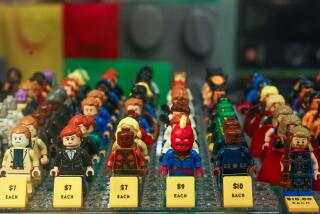‘Arthur’ Helps Tots; ‘Lego’ Not a Good Fit
- Share via
The preschool years are a time of great discovery. For many tots, that discovery includes a computer and the wonders that it can present. Some kids even consider the computer a house for their favorite characters.
So it’s important to choose preschool software carefully. There is a ton of preschool software on the market. But some, instead of enthralling children, may actually frustrate them.
Two recent releases--”Arthur’s Preschool” and “Lego My Style: Preschool”--illustrate the point perfectly. “Arthur” offers solid preschool fare; the Lego title, on the other hand, has several design flaws that undermine its exciting premise.
“Arthur’s Preschool”
Arthur, the aardvark star of books, television and software, invites preschoolers to join him as he visits eight of his friends. Each of Arthur’s friends wants to play a fun educational game with the player across three levels of difficulty.
Youngsters learn shapes and colors with Buster, the alphabet with Baby Kate, letter sounds with the Brain and counting with Francine. D.W. is the sorting guru, Muffy is the emotions maven and Mr. Ratburn is the master of matching.
The activity with Binky Barnes is particularly inventive. Here, children help Binky build bridges over puddles for ladybugs. Using leaves, sticks and flowers, children apply logic to figure out combinations that will fit over the puddle.
There are also creative activities such as making greeting cards and composing music.
Twenty additional activities can be printed out to play after computer time is over.
“Arthur” provides an unhurried, personalized atmosphere in which to learn. If your child’s name is one of the 500 recognized by the computer, Arthur will talk to your child by name. Throughout the program, your child’s name will appear at various locations.
What makes “Arthur’s Preschool” work so well is that it recognizes the child’s needs. Each activity starts with an excellent tutorial. If a child struggles to find the correct answer, the program highlights the right one. Further, Arthur will offer some additional instruction when needed. If the child succeeds, Arthur encourages the child to play at the next level of difficulty.
“Arthur’s Preschool” also has all the hallmarks of good preschool software: It creates a supportive and caring environment, features big graphics that are easy to understand, has lots of music and sound, talks to the child, puts the child in control of the exploration and doesn’t allow failure.
“Lego My Style: Preschool”
Unfortunately, “Lego My Style: Preschool” fails to live up to its lofty promise. Here is a software title with a concept that is brilliant. Unfortunately, its execution falls far short of the mark.
“My Style” starts with the premise that different children have different learning styles, a well-regarded theory originally presented by Dr. Howard Gardner, a psychologist and professor of education at Harvard University. For every educational topic taught, the player can choose to learn that topic in a manner consistent with one of five specific learning styles.
Each learning style is represented by a different Lego animal character.
* Giraffe uses a style perfect for children who learn best by using words to explain things.
* Elephant uses a style that approaches teaching in a logical manner, frequently using numbers or patterns and sequences.
* Monkey relies heavily on children being able to see or visualize what is being taught.
* Panda emphasizes learning in a musical environment.
* Horse employs a style that works best for constantly moving children who learn best when something is fast-paced and physical.
The software aims to teach four subjects: counting, letters, colors and music. Each subject has its own play area, represented by different Lego play sets. The barn is the place to learn about counting and numbers, the playground teaches the alphabet, the house presents colors and the jungle explores music.
Here’s how “My Style” works: At each game area, the five Lego animals wait, and each asks the child to play. By selecting an animal, the child is really selecting the manner of teaching. For example, at the barn (which teaches about numbers) if the player selects the panda (the musical learning style) the panda will start an activity in which she sings notes and asks the player to count them.
In theory, this is a great idea. Unfortunately, this and several of the other activities don’t work well. “My Style” is flawed because it doesn’t offer help when the child is having trouble, its feedback is not consistently supportive and its instructions are not always adequate.
In one activity, the child actually loses rewards already earned by doing a rhythm incorrectly! Go figure! “Lego My Style: Preschool” is a great concept. Let’s hope Lego rethinks the presentation and provides an upgrade soon.
*
Jinny Gudmundsen is the editor of Choosing Children’s Software magazine.
(BEGIN TEXT OF INFOBOX / INFOGRAPHIC)
The Skinny
“Arthur’s Preschool”
* Price: $19.95
* Publisher: Learning Co.
* Platform: PC/Mac
* System requirements: On a PC, a Pentium 75 with 16mb of RAM and 40mb of available hard disk space. On a Mac, a PowerPC with 16mb of RAM and 40mb of available hard disk space.
* Ages: 3 to 5 years
* Web site: https://www.shopmattel.com
* The good: Unhurried and encouraging
* The bad: Nothing much
* Bottom line: Solid preschool fare
*
“Lego My Style: Preschool”
* Price: $19.99
* Publisher: Lego Media
* Platform: PC/Mac
* System requirements: On a PC, a Pentium 200 with 32mb of RAM, 30mb of available hard disk space and a graphics card with 2mb of video RAM. On a Mac, a PowerPC 200 with 32mb of RAM and 30mb of available hard disk space.
* Ages: 2 to 4 years
* Web site: https://www.legomedia.com
* The good: Great concept
* The bad: Clumsy design
* Bottom line: Needs retooling
More to Read
The biggest entertainment stories
Get our big stories about Hollywood, film, television, music, arts, culture and more right in your inbox as soon as they publish.
You may occasionally receive promotional content from the Los Angeles Times.










